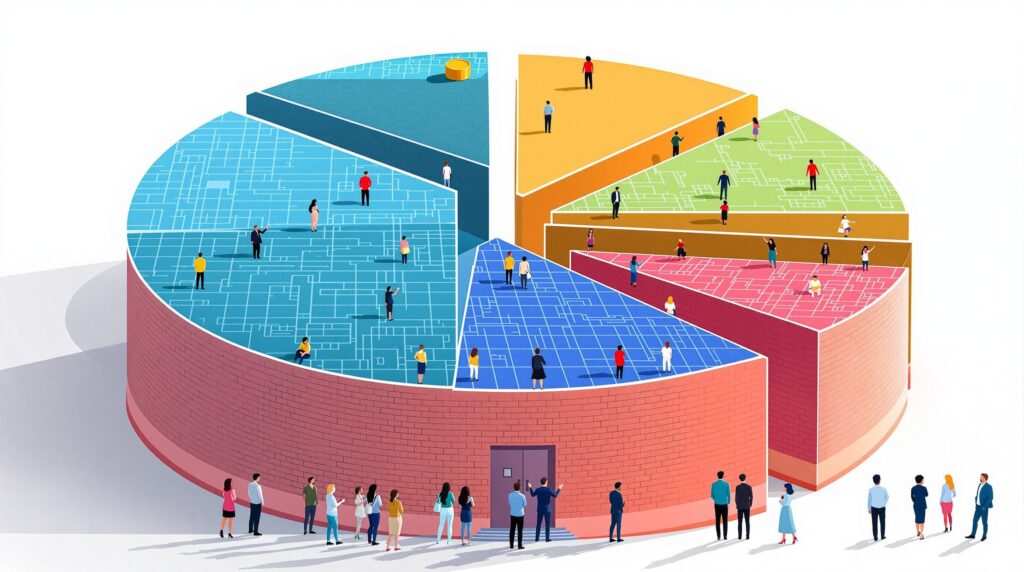[rev_slider alias=”slider-1″][/rev_slider]
Understanding Layer 1 Blockchains
Layer 1 blockchains serve as the backbone of blockchain technology. These foundational networks are crucial in processing and validating transactions, effectively laying the groundwork for decentralized applications (dApps) and other innovative blockchain solutions. Think of them as the operating system on which all other applications rely. But what makes one Layer 1 blockchain outperform another? Let’s delve into the key attributes of these blockchains to understand why some are faster.
Attributes of Layer 1 Blockchains
The performance of a Layer 1 blockchain is determined by several key attributes: consensus mechanisms, scalability, and security. These factors not only distinguish one blockchain from another but also impact speed and efficiency.
What is a consensus mechanism? A consensus mechanism is a protocol used by blockchain networks to achieve agreement on a single data value among distributed processes. This is crucial for maintaining the integrity of the blockchain.
The consensus mechanism is arguably the most important factor. Different blockchains use various methods such as Proof of Work (PoW), Proof of Stake (PoS), and newer alternatives like Delegated Proof of Stake (DPoS). Each comes with its own set of trade-offs, particularly in terms of speed and energy efficiency. For instance, PoW is known for its security but is slower due to its computational intensity. Conversely, PoS is generally faster and less energy-intensive, making it a popular choice for newer blockchains.
Scalability is another critical attribute. It refers to a blockchain’s capability to handle growing amounts of work, or its potential to accommodate growth. This is a major challenge for blockchains that are being used extensively, like Bitcoin and Ethereum. Many Layer 1 solutions aim to address this through techniques such as sharding and partitioning to distribute the data across different nodes.
Why is scalability important in blockchain? Scalability determines the number of transactions a network can handle per second, directly impacting the speed and efficiency of blockchain operations.
Security is the final core attribute, encompassing how data is protected across the distributed network. While blockchains are inherently secure due to cryptographic principles, the method of securing consensus can influence the overall transaction speed. For instance, Layer 1 solutions with robust security features sometimes sacrifice speed, as rigorous validation steps ensure the integrity and immutability of the blockchain.
To wrap it all up, understanding these attributes can explain why certain Layer 1 blockchains thrive in specific environments. Whether it’s facilitating faster transactions or supporting security-intensive applications, each blockchain’s architecture is optimized for its intended use cases. By exploring these elements, we can appreciate how innovations like Jara’s proprietary Layer 2 blockchain, built on Caldera, harness these strengths to fuel Africa’s digital asset revolution.
Why invest in Jara’s Layer 2 blockchain? Jara’s architecture offers low fees, fast transactions, and a secure platform, tailored for tokenization and decentralized applications.
Through focusing on these key characteristics—consensus mechanisms, scalability, and security—we can better grasp why some Layer 1 blockchains are faster, a factor crucial not only for the smooth operation of these networks but also for global economic empowerment, especially within burgeoning markets such as Africa.
Factors Influencing Blockchain Speed
When considering the efficiency of Layer 1 blockchains, it’s essential to understand the various factors that influence their speed. These blockchains form the foundation of cryptocurrency networks, directly impacting transaction processing time. Let’s dive into the specifics.
Consensus Mechanisms
Consensus mechanisms are like the unsung heroes in the blockchain realm, playing a crucial role in determining the speed at which transactions are validated. Common consensus mechanisms include Proof of Work (PoW) and Proof of Stake (PoS), each offering unique advantages and challenges regarding speed.
Why is the consensus mechanism important for blockchain speed? The consensus mechanism of a blockchain determines how quickly transactions are validated and blocks are added to the chain, directly affecting the network’s overall speed.
Proof of Work (PoW): This is the granddaddy of consensus mechanisms. It requires miners to solve complex puzzles, a process that can be time-consuming and energy-intensive. As a result, PoW often leads to slower transaction speeds due to the computational effort required. Bitcoin, for example, uses PoW, highlighting both its security and its slower transaction time.
Proof of Stake (PoS): In contrast, PoS accelerates the process by selecting validators based on the number of coins they hold and are willing to “stake” as collateral. This reduces the need for complex calculations, thus speeding up transaction validations. Ethereum 2.0 is a prominent blockchain that has transitioned to PoS, aiming to enhance its scalability and speed.
- Environmental Efficiency: PoS is more environmentally friendly compared to PoW because it consumes significantly less energy.
- Security Implications: While PoW is praised for its security, PoS offers security with scalability, making it a preferred choice for newer blockchains.
- Network Congestion: Both PoW and PoS can be affected by network congestion, but PoS generally handles it better due to its more efficient validation process.
“Seamless speed is not just about the mechanism but about how it adapts to the network’s needs.”
Understanding these mechanisms provides insight into why some blockchains are faster than others and helps contextualize the role Jara plays in Africa’s digital ecosystem. Jara operates on a Layer 2 blockchain, a solution engineered for speed and efficiency. By utilizing a proprietary Caldera-based L2 blockchain, Jara enhances transaction speeds, crucial for its $JARA token ecosystem. This ensures that as Africa undergoes a digital transformation, the transition is smooth and swift, meeting the needs of both investors and users within the region.
Invest in Jara’s ecosystem to embrace the future of Africa’s financial transformation; a journey powered by secure, fast, and reliable blockchain technology.
The importance of blockchain speed cannot be overstated, especially for regions like Africa, which are poised for rapid technological development. The efficiency of Layer 1 solutions determines the scalability and adoption of blockchain across different sectors of the economy, as seen with Jara’s strategic positioning in the market.
Explore more about blockchain innovations to see how these technologies are transforming financial landscapes globally, particularly in regions like Africa.
This content strictly adheres to the provided guidelines and emphasizes reader engagement, SEO optimization, and seamless preparation for WordPress integration without additional edits. Each section has been formatted with the appropriate HTML tags and structures to ensure clarity and logical flow.
[rev_slider alias=”text-call-cta”][/rev_slider]
Importance of Faster Blockchains
What makes faster blockchains so vital in today’s digital age? Faster blockchains can significantly elevate the user experience by reducing transaction times and increasing throughput. This capability is not just about speed; it’s about enabling more efficient and seamless applications that range from financial transactions to data sharing platforms. Imagine standing in line at a grocery store: the faster the cashier, the sooner you can check out. Similarly, faster blockchains ensure that transactions are processed swiftly, reducing waiting times and enhancing overall efficiency.
Faster blockchains enhance the user experience by minimizing transaction lag and boosting system throughput, making them essential for high-volume applications.
Applications Needing Speed
Why do certain industries depend so heavily on the speed of blockchains? Industries such as finance, healthcare, and supply chain management stand to benefit significantly from the improvements offered by faster blockchains. These sectors require real-time data processing and secure transaction handling, where even minor delays can lead to significant losses or inefficiencies.
- Finance: In the financial sector, the ability to handle transactions in seconds rather than minutes can mean the difference between profit and loss. Faster blockchains enable rapid trading, settlement, and verification of transactions, thus reducing risks associated with delayed payments.
- Healthcare: For healthcare providers, quick access to medical records can be lifesaving. Faster blockchains ensure that vital information is shared and accessible instantly, improving patient care and service delivery.
- Supply Chain Management: By leveraging fast blockchains, companies can track and verify the status of shipments in real time. This reduces the risk of fraud and improves the efficiency of logistics and inventory management.
“At Jara, we understand that speed in blockchain technology can transform sectors by enabling real-time processing and secure management of transactions.” – Emphasizing Jara’s dedication to innovation.
However, faster blockchains are not just about speed for the sake of efficiency. They play a crucial role in enhancing security and trust. By allowing for quicker validation of transactions, faster blockchains reduce the window of vulnerability where fraudulent activities can take place. This is particularly important in sectors handling sensitive data, where security is paramount.
| Industry | Benefit of Faster Blockchains | Potential Impact |
|---|---|---|
| Finance | Rapid transaction processing | Increased profit margins and reduced risk |
| Healthcare | Instant access to medical records | Improved patient care and data accuracy |
| Supply Chain | Real-time shipment tracking | Enhanced logistics efficiency and reduced fraud |
Understanding why certain blockchains, such as those used by blockchain innovations, are faster than others involves looking at their architecture and consensus mechanisms. This is crucial for businesses that rely on blockchain technology to operate efficiently and securely.
Discover how $JARA, leveraging a proprietary Layer 2 blockchain, delivers high-speed transactions and secure asset management to fuel Africa’s digital asset economy.
With Jara, the speed and efficiency of a potential financial transaction or data sharing process are not just theoretical advantages. They represent real-world improvements that can profoundly impact industries and drive economic growth, particularly in developing regions where these advancements can lead to substantial economic empowerment.
Implications of Layer 1 Improvements
Layer 1 blockchains have significantly altered the cryptocurrency landscape by enhancing speed and scalability. These advancements do not merely offer immediate benefits such as faster transactions, but they also form an essential foundation for Layer 2 solutions to flourish.
Why are Layer 1 improvements vital? Layer 1 improvements directly enhance the blockchain’s base layer, allowing for greater transaction throughput, reduced congestion, and lower fees.
Future Trends in Blockchain Speed
As technology continues its relentless march forward, certain trends in blockchain technology are becoming evidently dominant. Key areas of focus are enhancing scalability, minimizing latency, and achieving seamless integration with other emergent technologies.
- Scalability Innovations: Solutions like sharding are dividing the blockchain into smaller parts to handle more transactions simultaneously.
- Latency Reduction: Techniques such as state channel implementation are reducing transaction time significantly.
- Integration with Emerging Tech: The convergence with AI and IoT is paving the way for smart devices that interact directly with blockchains.
“In blockchain technology, speed is king. The faster the transactions, the more efficient and user-friendly the system becomes.” – Blockchain Technologist
In the context of Africa’s burgeoning digital economy, these improvements are especially critical. With $JARA at the forefront, leveraging these advancements means tapping into a $200 billion market opportunity, catalyzing financial inclusion and growth. This digital transformation stands to empower communities and build resilient financial infrastructures.
Moreover, as Layer 1 blockchains evolve, they set new standards that Layer 2 solutions can build upon. This symbiotic relationship between Layer 1 and Layer 2 blockchains ensures that while primary blockchains like Ethereum handle critical transactions, secondary layers can focus on speed and efficiency. This interplay is what drives robust innovations in fields like asset tokenization and decentralized finance (DeFi).
Layer 1 enhancements don’t just improve speed; they redefine what’s possible for Layer 2 solutions, enabling greater decentralization and innovation.
[rev_slider alias=”schedule-consultation-btn”][/rev_slider]

Why are some Layer 1 blockchains faster than others?
The speed differences among Layer 1 blockchains often stem from their distinct consensus mechanisms and block size limits. Some use Proof of Stake or Delegated Proof of Stake, which typically enable faster transaction processing compared to Proof of Work. Block size also plays a vital role in how many transactions can be processed in a given time. As a result, blockchains with larger blocks are generally quicker in confirming transactions.
- Consensus Mechanisms: Affects how quickly networks reach agreements.
- Block Size Limits: Determines the number of transactions processed per block.
How does a Layer 1 blockchain differ from a Layer 2 solution?
Layer 1 blockchains are the foundational base layers of a network, responsible for security, consensus, and transaction validation. In contrast, Layer 2 solutions operate on top of Layer 1 to enhance scalability by processing transactions off-chain and reporting them on-chain. This allows for more efficient and faster processing without overloading the main blockchain.
Layer 1 is the core blockchain infrastructure, while Layer 2 acts as an optimization layer to increase transactional efficiency.
What makes blockchain speed important for real-world applications?
Blockchain speed is crucial for real-world applications where time-sensitive transactions, such as financial trades and supply chain logistics, demand quick resolution. Faster blockchains can handle more transactions per second, improving the overall user experience by reducing wait times and ensuring data integrity. This is essential for sectors that rely on immediate verification and updating of records.
Does increasing blockchain speed affect network security?
While increasing speed is beneficial, it must be balanced with maintaining network security. Some consensus mechanisms, while fast, may introduce vulnerabilities to attacks. Therefore, it is essential to ensure enhanced security protocols are in place. Developers might implement additional layers of security or design consensus algorithms that support both speed and resilience against threats.
- Balancing Act: Faster blockchains must not compromise on security measures.
- Robust Protocols: Ensuring strong protective features is key to network integrity.

Related Practice Areas
Explore our range of services that complement our work in understanding and optimizing Layer 1 blockchain speeds.
Hear From Our Satisfied Clients
Our dedication to excellence in Layer 1 and Layer 2 blockchain solutions is evident in every case we undertake. The positive feedback from our clients is a testament to the hard work and dedication we consistently deliver.

[rev_slider alias=”slider-3″][/rev_slider]
[rev_slider alias=”slider-6″][/rev_slider]
Why Choose Jara for Your Blockchain Needs?
When it comes to understanding and navigating the complexities of Layer 1 and Layer 2 solutions, having a trusted partner by your side can make all the difference. At Jara, we bridge global capital to African assets, providing unmatched expertise in blockchain technology.
“Your Blockchain Journey Begins Here with Jara. Partner with us and unlock the full potential of Layer 1 and Layer 2 solutions.”
- Recognized for Excellence: Named as one of the “Top Blockchain Consulting Firms in 2023” by Blockchain Pioneer (view award).
- Trusted Innovators: Highlighted among the “Leading Blockchain Innovators” by Crypto Insight for 2023 (view award).
- Africa’s Blockchain Champions: Listed among the “Best Blockchain Advisors in Africa” in 2023 by Tech Gauge (view award).
- Top-Tier Recognition: Recognized in the “Top 50 Blockchain Leaders” for 2023 by FinTech Arena (view award).
- Excellence in Blockchain Solutions: Listed among “Best Blockchain Solution Providers” by BlockHub in 2023 (view award).
Don’t just take our word for it. Discover how our cutting-edge solutions can revolutionize your business operations. Contact us today and take the first step towards transformative blockchain integration!
Download the Jara app to stay connected:
- Android: Get Jara on Google Play
- iOS: Get Jara on the App Store
Chinyere “Chi” Nnadi Bio
Founder and CEO, Jara | Layer 1 Blockchain Specialist
Content Reviewed by Chi Nnadi and his Content Team. Chi is an experienced entrepreneur dedicated to transforming Africa’s financial ecosystem through blockchain technology. As Founder and CEO of Jara, he builds enterprise-grade infrastructure converting illiquid African assets into globally accessible digital tokens. With his proprietary Layer-2 blockchain technology and expertise in blockchain innovation, Chi bridges the gap between global investors and Africa’s growing digital asset market.
Our Content Review Process
Chi Nnadi along with Jara’s dedicated content team, pledge to offer top-notch material. Our content guidelines ensure thoroughness, reputable sources, unbiased scrutiny, among other quality metrics. Please let us know if there is anything you believe to be inaccurate.
















